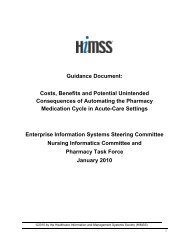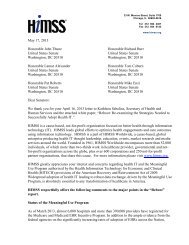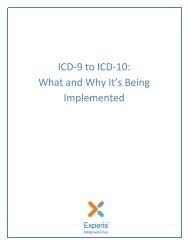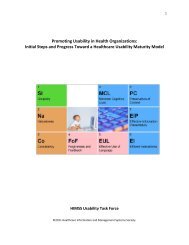Transitioning Clinical Quality Measures (CQM) from ... - HIMSS
Transitioning Clinical Quality Measures (CQM) from ... - HIMSS
Transitioning Clinical Quality Measures (CQM) from ... - HIMSS
Create successful ePaper yourself
Turn your PDF publications into a flip-book with our unique Google optimized e-Paper software.
<strong>Transitioning</strong> <strong>Clinical</strong> <strong>Quality</strong> <strong>Measures</strong> (<strong>CQM</strong>)<br />
<strong>from</strong> Abstracted to Electronic <strong>Measures</strong> (e<strong>Measures</strong>)<br />
Guidance Document<br />
March, 2012<br />
Developed by the <strong>HIMSS</strong> NQF Task Force with specific contributions <strong>from</strong> Zahid Butt MD, Cecilia<br />
Backman, MBA, RHIA, CPHQ; Melissa Honour, MPH; Bill Bell; and Amy Thorpe, MBA, PMP, F<strong>HIMSS</strong>.<br />
The <strong>HIMSS</strong> National <strong>Quality</strong> Forum (NQF) Task Force has written this Guidance document to<br />
provide information about the process of transitioning <strong>CQM</strong>s <strong>from</strong> abstracted to e<strong>Measures</strong>.<br />
This document provides the following:<br />
� Overview<br />
� e<strong>Measures</strong> design/redesign issues<br />
� Data capture issues in e<strong>Measures</strong><br />
� Coding and Classification Systems impacting e<strong>Measures</strong><br />
� e<strong>Measures</strong> impact on Clinician Workflow<br />
� <strong>Clinical</strong> Decision Support and e<strong>Measures</strong><br />
� e<strong>Measures</strong> Technical Considerations<br />
Overview<br />
<strong>Quality</strong> measurement is at the center of both public reporting and new forms of provider<br />
payments. Achievement of performance scores and reporting patient level quality data for a large<br />
number of clinical quality measures are crucial for healthcare providers. To date, NQF has<br />
endorsed more than 700 measures, with many more in the endorsement pipeline. For almost all<br />
of these measures collecting and reporting data is a complex, time-consuming, manual process<br />
for hospitals and physicians. Information collected in electronic health records (EHRs) should<br />
contain information required for performance measurement, and could be made available to<br />
automate the entire measurement process. Such a system, if fully developed and properly<br />
implemented, should eliminate the need for costly manual abstraction and result in greater<br />
confidence in comparing provider performance.<br />
Recognizing this promise of e<strong>Measures</strong>, the Department of Health and Human Services<br />
requested that NQF convert, or “retool,” 113 NQF-endorsed quality measures <strong>from</strong> a paperbased<br />
format to an electronic "e-Measure" format as part of the Health Information Technology<br />
for Economic and <strong>Clinical</strong> Health (HITECH) Act. In July, 2010, 44 of these 113 e<strong>Measures</strong> were<br />
published in PDF format in the Centers for Medicare and Medicaid Services’ (CMS) Electronic<br />
©2012 Healthcare Information and Management Systems Society (<strong>HIMSS</strong>).
Health Record Incentive Program Final Rule. NQF provided to CMS updates and general<br />
implementation guidance for those 44 e<strong>Measures</strong>.<br />
In addition, NQF has supported several initiatives necessary for the EHR Meaningful Use<br />
Incentive Program and worked in close collaboration with many members of the quality and<br />
health IT communities, including measure stewards to help create the necessary e<strong>Measures</strong><br />
reporting infrastructure. The building blocks of this infrastructure include development of the<br />
<strong>Quality</strong> Data Model (QDM), Healthcare <strong>Quality</strong> Measure Format (HQMF) development, e-<br />
Measure Format Review and the Measure Authoring Tool (MAT).<br />
In the near future this infrastructure will be leveraged to “re-tool” a significant number of the<br />
existing endorsed measures or to create “De Novo” e<strong>Measures</strong> that will leverage rich clinical<br />
data within EHRs using more streamlined algorithms. Stage I requires only reporting of<br />
e<strong>Measures</strong> while it is anticipated that actual performance results of an expanded list of measures<br />
may be required in future Stages of Meaningful Use.<br />
As this new infrastructure undergoes maturation and quality measurement transitions <strong>from</strong><br />
paper/abstracted measures to e<strong>Measures</strong>, several short and medium term challenges will have to<br />
be overcome. Intelligent design or redesign of clinician workflow to capture key data elements in<br />
a structured format without overburdening providers will be necessary for short term and crucial<br />
for long term sustainability. Such documentation within EHRs should primarily support patient<br />
care with quality reporting as an important “secondary use.” Once these data are captured<br />
accurately, creating data submission files and generating measures performance rates through<br />
certified <strong>CQM</strong> products should not be very difficult. The remainder of this guidance document<br />
provides more details about key issues relevant to successful e<strong>Measures</strong> implementation.<br />
e<strong>Measures</strong> Workflow Design/Redesign Issues<br />
NQF has invested a great deal of time and effort to “retool” quality measures in support of EHRs<br />
and Meaningful Use. However, <strong>from</strong> a provider perspective, this is just the beginning of a new<br />
journey in quality measurement. Provider organizations will need to focus on both the technical<br />
and clinical workflow for successful implementations. There are many EHRs on the market and<br />
they differ in their level of complexity and maturity. In addition, some organizations have<br />
developed their own internal EHR systems. Thus, <strong>from</strong> a technical perspective, one size will not<br />
fit all when embedding the measures into an EHR. Although the measures will be common, the<br />
systems that will serve as the source for data will be quite different and each system will present<br />
its own unique set of challenges.<br />
e<strong>Measures</strong>’ Impact on Data Capture<br />
Organizations will need to make accommodations for more structured and standardized data<br />
within their EHR. Most systems today accommodate ICD-9-CM and CPT codes, the systems<br />
will in future need to support additional data standards such as LOINC, Rx Norm, and<br />
SNOMED. e<strong>Measures</strong> rely heavily on standardized taxonomies and vocabularies to capture data<br />
©2012 Healthcare Information and Management Systems Society (<strong>HIMSS</strong>).
for quality measurement. This will create the need to develop a more robust, highly<br />
sophisticated vocabulary within the EHR. The starter set of data generally offered by a vendor<br />
will no longer meet the needs of a healthcare organization. Vendors will need to devote<br />
development time to retool their systems to accommodate new types of data sets and providers<br />
will need to devote implementation resources so that these data are captured in a structured<br />
format at the point of care. Decisions will need to be reached on how these data will be<br />
represented and captured within an EHR. Design considerations will include whether to use<br />
electronic forms for highly structured data capture or utilize other technologies such as natural<br />
language processing to take less structured documentation and encode it as structured data for<br />
quality reporting. Standardized vocabulary usage and the technical infrastructure that will<br />
support it will be two important areas of consideration when implementing e<strong>Measures</strong>.<br />
Data Governance and Data <strong>Quality</strong><br />
As noted above, EHRs will continue to evolve to incorporate new types of data sets and will be<br />
captured in a structured format at the point of care. Decisions will need to be reached on how<br />
this data will be represented and captured within an EHR. These decisions and the resulting<br />
design of data capture methodologies constitute the metadata, literally the “data about the data.”<br />
This metadata describes the overall design of the EHR and documents the design decisions that<br />
guided the specific system design to capture data necessary to satisfy the reporting requirements.<br />
As requirements for reporting grow, this design will have to evolve. These changes must be<br />
managed through a formal data governance process so that proposed changes can be evaluated<br />
and managed, and the organization can be assured that the overall system continues to meet all<br />
the reporting requirements. Key stakeholders <strong>from</strong> clinical and operational areas and quality<br />
reporting should be involved as well as information technology to ensure proposed changes do<br />
not adversely impact the ability to meet quality reporting specifications. For example, there may<br />
be a request to streamline a charting screen to improve usability and speed of documentation for<br />
an end user. By evaluating this change request through a data governance process, all<br />
stakeholders collaborate to ensure that the changes to the system do not result in the loss of the<br />
ability to capture key quality data points as was the intent of the original design. Finally, an<br />
integrated and rigorous change control process will ensure that approved changes are<br />
implemented and that appropriate communication about the change will be provided to all the<br />
users of the system. The metadata itself is also updated so that it continues to function as a<br />
repository of the cumulative design decisions that are reflected in the current system build<br />
version.<br />
Data Validation<br />
Data validation is the process by which collected data is tested and shown to be accurate and<br />
reliable. In Stage 1 for Meaningful Use, there is no specific requirement for meaningful users to<br />
demonstrate how they are validating the quality data they are submitting. The requirement is to<br />
report the calculated numerators, denominators, and exclusions though “attestation”. This is<br />
likely to change quickly over the next few years. As quality reporting moves <strong>from</strong> pay for<br />
reporting to pay for performance in general, it will be critical to ensure that data is documented<br />
correctly in the source system and that quality measures are calculated correctly by the reporting<br />
system. A formal process for proactively reviewing quality data and measure calculation should<br />
be a collaborative effort amongst the key stakeholders <strong>from</strong> clinical and operational areas and<br />
©2012 Healthcare Information and Management Systems Society (<strong>HIMSS</strong>).
quality reporting. This process should be designed to ensure that data is being captured and<br />
reported correctly. First, compliance in documentation in the source systems must be examined<br />
to ensure that data is being captured as expected. Secondly, the quality of that data should be<br />
evaluated to ensure that what is recorded electronically agrees with other information in the<br />
patient’s record. Finally, technical issues affecting data transmission should be evaluated to<br />
determine if the source system agrees with the output as contained in the quality reporting<br />
module. By working to establish a collaborative data governance process now, organizations<br />
will be well positioned to meet the growing requirement of electronic reporting of quality data in<br />
future.<br />
Coding and Classification Systems impacting e<strong>Measures</strong><br />
As noted, e<strong>Measures</strong> will use many data standards including ICD-9-CM/ICD-10-CM, CPT,<br />
LOINC, Rx Norm and SNOMED as a means to capture and report data. A brief description of<br />
each of these coding and classification systems that have been selected as standards in the<br />
Meaningful Use Incentive Program and have a direct impact on e<strong>Measures</strong> reporting follows:<br />
• ICD-9-CM/ICD-10-CM – ICD is the International Classification of Diseases and Related<br />
Health Problems that is used to classify disease as well as signs, symptoms, abnormal<br />
findings, complaints, social circumstances, and the external causes of disease or injury. The<br />
classification system is published by the World Health Organization and it is used to track<br />
morbidity and mortality worldwide. ICD has a long history of use in the U.S. It was first<br />
used for reporting morbidity and mortality in 1900. The first two volumes of ICD-9-CM<br />
address diagnoses. The third volume of ICD-9-CM addresses procedures and was developed<br />
for use in the U.S. mostly for inpatient care.<br />
ICD-10 is a newer version of ICD and it became available for use worldwide in 1994. Many<br />
countries have adopted it since that time. However, because the U.S. reimbursement systems<br />
are so heavily tied to the use of ICD 9, ICD-10-CM will not be implemented in the U.S. until<br />
October 1, 2013. The next version, ICD-11 is now under development and will be available<br />
for use in 2015. The National Committee for Health Statistics and CMS oversee all changes<br />
and modifications to ICD in the U.S.<br />
• CPT – The Current Procedural Terminology (CPT) coding system was developed for use by<br />
the American Medical Association (AMA). It is used exclusively for professional billing and<br />
hospitals use it for billing outpatient procedures and services. This system is also intricately<br />
tied to reimbursement in the U.S. It is overseen by a CPT Editorial Panel at the AMA that<br />
determines updates and enhancements. CPT focuses only on the services rendered as<br />
opposed to ICD-9-CM which focuses on both the diagnoses assigned to a patient as well as<br />
services provided. CMS classifies CPT as a Level 1 Healthcare Procedure Coding System<br />
(HCPCS) for billing and reimbursement purposes.<br />
LOINC – LOINC was originally developed to facilitate the movement of clinical results data<br />
between a laboratory system and the other systems used to support patient care. LOINC<br />
stands for Logical Observation Identifiers Names and Codes. Its purpose is to facilitate the<br />
exchange and pooling of results for patient care, research, and outcomes management. The<br />
laboratory portion of this coding system addresses all aspects of the laboratory. The clinical<br />
©2012 Healthcare Information and Management Systems Society (<strong>HIMSS</strong>).
observation portion of the coding system deals with clinical data such as vital signs,<br />
intake/output, pulmonary ventilator management, and many other clinical observations. The<br />
LOINC effort is housed in the Regenstrief Institute, an internationally respected non-profit<br />
medical research organization that is affiliated with Indiana University.<br />
• RxNorm – RxNorm is a standardized nomenclature that provides normalized names for<br />
clinical drugs and drug delivery services. This normalization allows for the linking of the<br />
RxNorm code to many drug vocabularies commonly used in pharmacy management systems<br />
as well as drug interaction software. For example, RxNorm can link to First Databank,<br />
Micromedex, MediSpan, Gold Standard Alchemy, and Multum. This linking allows<br />
RxNorm to standardize and mediate messages between systems that do not use the same<br />
software or the same vocabulary. RxNorm is produced by the National Library of Medicine.<br />
• SNOMED CT – Like ICD-9-CM, SNOMED CT is an international terminology system.<br />
SNOMED CT is used to define clinical medicine and disease. It was initially developed by<br />
the College of American Pathologists. SNOMED stands for the Systematized Nomenclature<br />
of Medicine and CT stands for the computable form of this classification system. It was<br />
designed to support both human and veterinary medicine. It is a multiaxial, hierarchical<br />
system that is based on 11 axes that serve as a basis for defining medical concepts. These<br />
axes address topography; morphology; living organisms; chemicals; function; occupation;<br />
diagnosis; procedure; physical agents, forces, and activities; social context; and general.<br />
Through mapping, many other systems that code and classify diseases or conditions can be<br />
mapped to SNOMED CT in order to normalize data within an electronic system. An<br />
example of this is the mapping of a standardized nursing language such as NANDA to<br />
SNOMED CT. ICD-9-CM has also been mapped to SNOMED CT. Since it supports such a<br />
large number of medical concepts it is often considered by organizations when building a<br />
common vocabulary within an electronic record system and is included in many e<strong>Measures</strong><br />
specifications.<br />
e<strong>Measures</strong>’ Impact on Clinician Workflow<br />
Workflow design (or redesign) is crucial for a successful implementation and to derive value<br />
<strong>from</strong> e<strong>Measures</strong>. For example, if the eMeasure speaks to an appropriate action that should be<br />
taken in response to an event, the action needs to be documented at the time it is taken rather<br />
than at end of shift if the data is to be accurately reflective of what occurred. These measures<br />
will not only be dependent upon what is documented by clinicians, but they will also be<br />
dependent upon variables such as time, care setting, patient demographics, and other variables<br />
that are not generally the primary focus of a caregiver. Thus, it will necessitate that all<br />
documentation become more accurate and timely.<br />
Changes in the way information is captured will have a direct impact on all disciplines<br />
documenting within a medical record. It is anticipated that a portion of the documentation will<br />
become more structured and there will be more data standardization between organizations and<br />
vendor products. It will be imperative that documentation be complete so that the results<br />
published accurately identify the activity of the organization and its performance rates on quality<br />
measures.<br />
©2012 Healthcare Information and Management Systems Society (<strong>HIMSS</strong>).
Figure 1 illustrates an example of workflows and clinician structured data capture for a Stroke<br />
eMeasure: Antithrombotic Therapy on Discharge.<br />
Figure 1. Used with permission of Encore Health Resources.<br />
This example shows how data collection as specified in a measure impact several different<br />
workflows. Admission Order Sets, Discharge Order Sets, Problem List and Admission<br />
Assessments are used in this example to capture the necessary data. These data are used by the<br />
e<strong>Measures</strong> algorithm to determine whether this case is selected in the denominator for the<br />
measure. Denominator exclusions will likely be challenging for providers. Though variables<br />
such as comfort measures or involvement in a clinical trial are relatively rare for a particular<br />
measure set, new workflows designed to capture these data discreetly will require every patient<br />
to be assessed for both of these. Providers will likely view this as additional work without<br />
significant added value.<br />
This example also illustrates how e<strong>Measures</strong> could have a direct impact on existing coding and<br />
abstracting practices within medical records. As providers start entering final diagnosis codes<br />
and EHRs become more capable of automatically encoding and abstracting data, both coders and<br />
abstractors will move away <strong>from</strong> these functions and their efforts will be redirected towards data<br />
analysis. Organizations can then focus more on the information presented by the measures which<br />
will lead to continuous quality improvement for the betterment of patients and provider<br />
organizations.<br />
©2012 Healthcare Information and Management Systems Society (<strong>HIMSS</strong>).
e<strong>Measures</strong> and <strong>Clinical</strong> Decision Support (CDS)<br />
<strong>Clinical</strong> Decision Support (CDS) at the point of care has great potential for improving quality of<br />
care. CDS rules could be made available or preferably embedded in the workflow to assist<br />
providers in improved compliance with clinical practice guidelines and documentation. One of<br />
the challenges to utilizing CDS for inpatient quality measures currently is that patients qualifying<br />
for a particular measure set are often identified <strong>from</strong> billing data which is completed after the<br />
patient has been discharged. At this point, it is too late to impact the patient’s care. As shown in<br />
the above diagram, new workflows will be required to capture discreet data during care delivery<br />
for e<strong>Measures</strong> and will have clinicians completing the problem list early in the patient’s stay.<br />
Identifying patients at this early point will allow for decision support to be embedded throughout<br />
the stay, and give the opportunity to layer decision support to capture measures that may be<br />
missed by a particular clinician. This should dramatically improve quality measure rates and get<br />
us closer to every patient receiving the right care every time. As shown in the example in Figure<br />
1, the e<strong>Measures</strong> framework lends itself to incorporate CDS rules in key workflows positively<br />
impacting performance and outcomes.<br />
e<strong>Measures</strong> Technical Framework<br />
Successful implementation of e<strong>Measures</strong> requires several technical considerations for EHR<br />
vendors and provider organizations implementing e<strong>Measures</strong>.<br />
Vendor Considerations<br />
Coding Management Systems: e<strong>Measures</strong> require clinical data to be mapped to the most up-to<br />
date version of ICD-9-CM/ICD-10-CM, CPT, LOINC, Rx Norm and SNOMED coding.<br />
Historically, vendors did not always provide coding management systems or tools to facilitate<br />
this process. To accommodate these requirement vendors will need to provide implementation<br />
tools to manage and update coding systems. The coding management system should be designed<br />
similar to other configuration tools and allow for automated mapping of standard clinical<br />
elements such as orders, results, observations, and problems to the appropriate coding schemas.<br />
The vendor should provide tools that allow for the flexibility of mapping to custom database<br />
fields since many providers and hospitals have customized their EHR implementations.<br />
Additional consideration should be provided for the implementation of new codes or required<br />
deletion of expired codes.<br />
Provider Considerations<br />
Key stakeholders within an organization should be involved <strong>from</strong> the beginning of the process.<br />
Evaluation and feedback should be sought <strong>from</strong> all stakeholders (programmers, analysts,<br />
clinicians) across all levels of involvement (mild, moderate, and heavy). Information <strong>from</strong> all<br />
locations and all formats should be accepted to collect comprehensive feedback.<br />
Completing a readiness assessment prior to initiating e<strong>Measures</strong> implementation and integration<br />
efforts will be very helpful to both providers and vendors. Sufficient time and resources should<br />
be allocated to managing inter-organizational issues at the planning stage of the project.<br />
©2012 Healthcare Information and Management Systems Society (<strong>HIMSS</strong>).
In summary, this guidance document provides a roadmap for successful transition <strong>from</strong><br />
abstraction-based performance measurement to a more direct electronic platform, pointing out<br />
key differences between the two. Informaticians, providers and quality improvement personnel<br />
should work closely with each other to leverage the opportunities and to deal with the challenges<br />
of this new paradigm designed for improved patient care.<br />
Contact Us<br />
For more information, contact Jonathan French, Director, Healthcare Information Systems, at<br />
jfrench@himss.org.<br />
©2012 Healthcare Information and Management Systems Society (<strong>HIMSS</strong>).

















